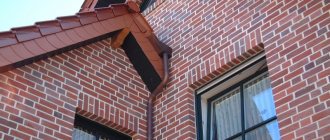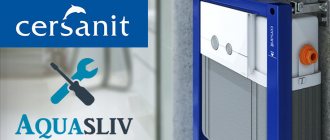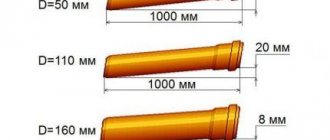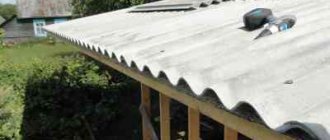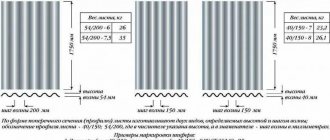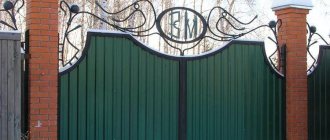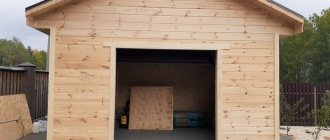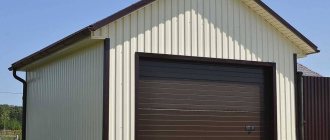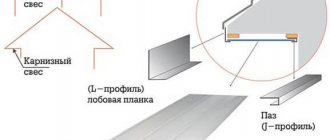Covering a roof with your own hands is not that difficult, but first you need to choose the material. One of the roof covering options is corrugated sheeting (a durable, practical and affordable material). A corrugated sheet or metal profile is a sheet of metal with a protective coating. The ridges and grooves make it more rigid, which increases its service life. At the same time, the material turns out to be light, so that a roof made of corrugated sheets can be made even by one person.
Corrugated sheet roofing
Features of the material
At first glance, all types of metal profiles are the same and differ only in color. However, when purchasing roofing material, several parameters should be taken into account. Of great importance is the slope of the slopes, which determines the pitch of the sheathing and the brand of sheets.
The profile flooring is mounted on slopes with an inclination angle of 12 degrees. It is permissible to lay corrugated sheets on flatter roofs; in this case, you will have to strengthen the rafter structures, sheathing and additionally seal the joints of the sheets.
How to choose the angle of inclination
If the roof area is small, the load allows the use of corrugated sheeting grades C18-C21. For large spans the load-bearing capacity of such materials is not enough, so more powerful types of flooring NS35-NS60 are used.
The minimum tilt angle for residential buildings should not be less than 10°, for industrial facilities or sheds - 8°. But with such a slope, the sheathing boards should be laid almost flush together. In addition, if the angle is too small, there is a high probability of leaks, which requires additional sealing of the seams and laying corrugated sheets with an overlap of 2 waves.
The angle of inclination of the roof is selected based on the loads and the architectural design. It should be taken into account that the more snow falls in the region, the steeper the slopes should be.
Wind load is a risk factor for roofs with a steep slope. In strong winds it needs to be made flatter.
The wind tore off the roof
The optimal angle for pitched roofs is 20-45°. It allows you to lay the lathing in increments of 500-1000 mm without the risk of deformation under load.
Performance qualities of corrugated sheets
Profiled sheet C-10 and its dimensions.
The greater the height of the sheet profile, the stiffer the material. Roofers advise choosing corrugated sheeting with a height of 20 mm or more for the roof. Metal profiles of grade C10 can also be used, but you need to think about the unhindered flow of snow from the roof. Let's look at the main types of profiled sheets:
- Wall. Owners of private houses usually choose brands C10, C20 and C21. They optimally combine cost and characteristics.
- Load-bearing - wall. Brand NS35 is suitable for roofs with a minimum slope. Load-bearing wall sheets of this brand are used in areas with heavy snow load.
Profiled sheet NS35 and its dimensions
The corrugated sheets H60 and H75 have a high cost - their wave height exceeds 6 cm. They are not used for roofing private houses, but they are quite suitable for industrial facilities.
What is a profiled sheet and how to cover a roof with it
Thanks to the development of advanced technologies, new materials have appeared in construction with high performance characteristics and an affordable price. High-tech building materials include corrugated sheets - galvanized corrugated metal sheets of various sizes with or without polymer coating.
Sheets of corrugated sheets of various colors and with different corrugation heights.
On the outside, the profiled sheet consists of the following layers:
- galvanized sheet - the basis of the corrugated sheet;
- anti-corrosion coating;
- polymer coating;
- protective mounting film.
On the inside, the sheet can also be protected with an anti-corrosion layer and protective varnish.
Types of corrugated sheets (grades)
Sheets of corrugated sheets differ in color, the presence of a protective coating, and material. Non-ferrous metal profiles are used to cover the roofs of private houses. The polymer layer protects the metal from negative environmental factors, and the selected shade completes the appearance of the building. Although simple galvanized sheets are much cheaper, they are only suitable for temporary structures and the service life of such material is shorter.
By purpose
As already mentioned, metal profiles come in different thicknesses and have deep or minimal grooves. Sheets with small indentations (marked “C” on them) are used for walls or fences. Making a roof from a thin metal profile is not the best idea only if there is frequent sheathing and there is no heavy snow load.
Sheets made of thick metal (marked with the “H” code) are intended for roofing with high snow or wind loads. Universal corrugated sheeting is designated by two letters “NS” and is suitable for most homes.
When marking, you can notice the numbers - this is the wave height indicated in millimeters. For example, wall C10 is suitable for a fence, and HC30 is recommended for roofing. Additional grooves in the wave increase the rigidity of the corrugated sheet.
By type of coverage
Despite the same appearance, the price of two sheets of corrugated sheets may differ. For some reason, many take this as deception on the part of the store, but no. It's all about using different materials and technologies. The coating is:
- Tsinkov - the technology is well studied and put into production, so the cost of the sheets is lower;
- Alyumotsinkov is a relatively new technique, which means that the price of a metal profile reflects the costs of modern equipment, while this type of protection extends the service life of the product.
Waves on a profiled sheet are formed using cold rolling or emulsion.
In the first case, the metal is pressed through with a special roller without preparation. The work uses expensive equipment, otherwise there is a risk of damaging the applied protective layer on the sheets.
During the formation of a wave by an emulsion, the surface of the material is treated with oil or water and then pressed. It is very important not to violate the technology: first dry the sheets and then fix the paint by firing in an oven. If the manufacturer did not treat the work conscientiously, the material will soon rust.
Popular coatings include polyester, pural, PVDF, plastisol. The advantages and disadvantages of each are presented in the table.
| Type of polymer coating | pros | Minuses |
| Polyester | Low price, plastic layer, resistance to damage during installation of metal profiles | Glossy polyester glares and is susceptible to corrosion |
| Pural | Uniform and reliable coating, color protection for 10 years | High price |
| Plastisol | Resistant to environmental factors, does not rust, has an affordable price tag | Destroyed by exposure to ultraviolet radiation (fades) |
| PVDF | Tolerates any frost, sun and even aggressive environments. The coating is easily cleaned of dirt during rain, which returns the roof a beautiful shine | Expensive, not always available in small towns |
The best option for a country house is a roof made of corrugated sheets with a protective polyester coating. Corrosion can only occur if the installation technology is incorrect or the sheets are damaged during transportation.
Advantages of using profiled sheets in construction
Thanks to its high protective characteristics and aesthetic qualities, corrugated sheets are simply irreplaceable when arranging a roof. The convenience of using this material also lies in the fact that wall cladding, installation of fences and roofing with corrugated sheets can be done with your own hands. Numerous specialized websites have video and photo instructions on how to cover a roof with corrugated sheet metal.
High strength, anti-corrosion properties and rigidity, combined with a variety of sizes and low weight, have ensured the popularity of corrugated sheets in the construction of various types of premises.
Even a non-professional can install profiled sheets.
The main advantages of using profiled sheets include the following:
- durability;
- resistance to corrosion;
- rigidity;
- light weight;
- versatility;
- ease of self-installation;
- availability of component materials;
- ease of transportation and storage;
- low price;
- wide choice of sizes;
- high aesthetics of the coating.
A roof made of corrugated sheets is not subject to corrosion.
The use of profiled sheets speeds up the time and overall costs of DIY construction. A small number of joints ensures the reliability and tightness of the structure, and the low weight allows even beginners to attach the corrugated sheet.
How to lay corrugated sheets on a roof
Installation is often entrusted to craftsmen, although you can properly cover the roof with corrugated sheets yourself. The main thing is to prepare the necessary tools and follow the technology. To begin with, they construct a sheathing from boards with a pitch of no more than 60 cm. The thickness of the inch edged board is about three cm. The corrugated sheet should be laid on the roof in such a way that each layer overlaps the previous one by one wave. The short shelf should be at the bottom, and the long one should cover the short one. Only in this case a reliable coating without gaps is formed. By mixing up the shelves, a space of a couple of millimeters appears, but this is enough for water to leak.
What to cut
There is practically no such thing that the corrugated roofing does not need to be trimmed. Under no circumstances should you use an angle grinder! This is quick and easy, but when cut, the metal becomes very hot, and the high temperature causes the zinc to evaporate. In addition, the abrasive tool violates the integrity of the coating. Soon the sheet in these places will begin to rust.
Manufacturers advise using manual or electric metal shears. A drill with a “steel beaver” attachment, a cutter with a metal disc, and a jigsaw are suitable.
What tools will be needed for installation?
To install corrugated sheeting on the roof, you need a universal set of tools:
- Roulette with a length of 6 meters;
- Folding meter or laser rangefinder;
- Construction square - with the help of it you can check the corners of the sheathing;
- Metal ruler;
- Plumb line for setting up vertical posts;
- Building level.
To record measurements, it is enough to prepare a notepad and pencil. It is more convenient to mark metal sheets with a marker - it is not erased by your fingers while working.
In addition, you will need electric tools - they will make laying corrugated sheets faster. You definitely need to get a screwdriver, since even a small roof has many connections. It is very tedious to tighten screws with a screwdriver, and you won’t be able to apply enough clamping force.
A grinder with attachments will allow you to grind or grind down parts if necessary. Plus, you can take a circular saw and a jigsaw. Nozzles are selected separately for each tool. A hammer drill is often required to remove the chimney or ventilation pipes.
Do not forget about safety precautions when installing a roof made of corrugated sheets. You need to stock up on gloves, safety glasses and a respirator (for working with paint or impregnations).
Installation procedure
They begin laying the corrugated sheet on the roof after assembling the rafter system, installing hooks for the drainage system and a drip line. The waterproofing film is “hidden” under the edge of the drip edge and everything is secured with self-tapping screws. All that remains is to install the eaves strip, make the sheathing and only then place the metal profile on the roof.
Foundation construction and waterproofing
Installation of a vapor-waterproofing membrane
The procedure for installing a base under a corrugated sheet depends on whether you plan to make the attic warm or cold.
If the attic space is planned to be cold, then the sequence of the foundation installation will be as follows:
- A vapor-waterproofing film is stuffed from the lower edge of the rafters, which is secured with staples;
- The rows are laid overlapping (overlapping 15 cm) and taped;
- The film should sag slightly under the rafters - at low temperatures it can become very stretched and tear.
If the roof is insulated, then the scope of work increases and changes:
- Counter slats are installed on top of the rafters, which create space for ventilation between the roofing and waterproofing, which prevents moisture from accumulating;
- After this, a sheathing is constructed from the attic side, which will hold the insulation and vapor barrier;
- A roof made of metal profiles is laid on the counter-rails.
Installation of insulation under the roof covering
Installation of extensions and end boards
Varieties of additional roofing elements made from corrugated sheets
Before covering the roof with corrugated sheets, you should install a wind board. It blocks the access of air flows under the roof, and also serves as the basis for installing the wind strip. It is very important that the top cut is slightly further than the sheathing.
Now we mount the cornice strip along the lower edge of the slope. It remains to install a valley overlap of 10-15 cm in places where the roof breaks (direction from bottom to top).
Laying and fastening corrugated sheeting on the roof
Three-block scheme for laying corrugated boards Four-block scheme for laying corrugated sheets
First you need to decide on the installation method and fasteners. You can start laying metal profiles on single- and double-slope roofs from any end. The hip roof is covered only from the longitudinal central axis of each hip. In both cases, you need to pull the cord along the cornice - they are guided by it, aligning the corrugated sheet. The construction of a roof made of corrugated sheets over lathing depends on the chosen method:
- Three-block. Lay 2 corrugated sheets in the first row, align, and secure temporarily. Next put one sheet for the second row. Aligning all layers, finally fix the block. Continue laying the corrugated board according to the checkerboard pattern.
- Four-block. Lay one corrugated sheet for the first and second rows in turn. After that - the second sheet of the first and the second sheet of the second row. Everything is fixed with temporary fasteners to the sheathing. After leveling the block, you can attach the corrugated sheet to the screws.
The sheets must be overlapped so that there is no gap. The direction of the joints is any, but the same. It is better to immediately paint over scratches and defects if the coating is accidentally damaged during installation. This will prevent corrosion in the future.
For a roof with a small slope, it is recommended to lay the sheet with an overlap of 2 waves. Another option is to use a gasket seal.
The metal profile is secured with galvanized self-tapping screws of suitable length with a neoprene gasket. It is worth choosing fasteners with heads that match the color of the roof so that they are not noticeable. The absence of a gasket will negatively affect the roofing system - moisture will easily penetrate through the holes.
Installation of finishing panels
Installation of the ridge on the roof
Most of the work is behind us - it remains to complete a few important elements for the roof made of corrugated sheets. The ridge should be attached to the metal tile with roofing screws with an overlap (up to 15 cm), not forgetting about the seal.
The remaining elements are left to the discretion of the home owner. Many people install snow retention devices above the entrance or parking space.
Work order
When studying the question of how to properly cover a roof with corrugated sheeting, you should familiarize yourself with the order of performing all stages of the work.
Lathing
It is possible to make a lathing for laying profile sheets either continuous or with intervals. The step in this case is determined by the degree of inclination of the slope. With a slight slope, the planks are placed at a distance of 300-400 mm, and with a slope of more than 15 degrees, the step can be increased to 600 mm.
Installation
- In any case, laying of profile sheets is carried out from the bottom up. With this scheme, moisture will not get into the connecting seams.
- Experts recommend preparing preliminary drawings and diagrams taking into account the direction of the winds prevailing in the area.
- In a situation where the wind usually blows from right to left, installation is performed from left to right.
- If the length of the sheet corresponds to the size of the slope, then installation begins from the end of the roof, aligning the edge of the sheet along the eaves line (with a plumb line of 40 cm).
Step-by-step instructions will help you complete the task.
- The very first sheet must be carefully aligned and immediately fixed with one self-tapping screw approximately in the middle of the sheet.
- The second profile sheet is laid with the desired overlap, leveled and fixed again with one screw.
- Having secured the profile sheets in a similar order along the entire length of the roof, they are carefully aligned along the eaves line.
- The profile sheets are fixed at the ridge by screwing screws through one deflection.
- Then they begin high-quality fixation of the roofing material, securing the screws through the vertical pitch of the sheathing.
- In the horizontal direction, they are fixed with a frequency of every second step of the wave, and along the upper and lower edges the self-tapping screws are screwed into each deflection of the profile sheet.
In this case, the joints must be secured with additional elements. Excess metal is cut off. This is how you make a pitched roof from a profile with your own hands.
- If the roof has two slopes, the second side is covered with sheets in the same order.
- At the next stage, the end strip is attached towards the ridge. It is attached to the crest of the wave and extended with an overlap of at least 50 mm.
- The ridge is fixed to a seal with an adhesive base, placing screws at a distance of at least 300 mm.
It is easy to understand the entire roofing process in more detail if you watch the video.
Corrugated roofing: components
Difficult areas are called nodes - they require additional attention. Usually these are the junctions of different planes and parts of the structure.
Installation and sealing of the ridge
The principle of insulating the roof ridge
Under the roof, it is imperative to provide space for ventilation, since condensation accumulates there. When installing a profiled sheet at the top, the sheets do not meet each other - a gap is required. It is this that ensures the outflow of air and steam. The higher the wave on the sheets, the larger the hole. You can choose a special skate with ventilation.
A large gap is not always good. There is a high probability that the holes will become clogged with dust, snow or leaves, which will impair ventilation. Experts recommend reducing the gap by 2/3 by filling it with sealant, or using a sealant.
Finishing the overhang with corrugated sheets
Sheathing the roof overhang Sheathing
the roof overhang is quite simple by attaching a suitable profile with grooves to the front board. Pre-cut sheets of corrugated board of the desired width are inserted into them. After this, the second edge is hemmed to the board nailed to the rafters. Close the joints with droppers: one from below, the other from above. A hydrofilm is laid on top of it.
For drainage, gutter hooks are mounted after the bottom drip. The upper one in this case is attached after installing the hooks.
Connecting corrugated sheeting to the wall
The principle of arranging a corrugated sheet to a wall
If the corrugated sheet is adjacent to the wall of a structure, it is necessary to ensure sealing to avoid leaks. A corner strip of a certain length is used: for the roof - long, for mounting on the wall - short. You can choose nails, screws, or dowels as fasteners. The joints are treated with silicone sealant.
There is also an option: cut a groove in the wall, install a corner strip with curved shelves (inclination angle 45 degrees). Everything is secured to the roof, as in the previous version, with self-tapping screws with rubber gaskets.
Pipe passage
Pipe passage through the roof
Steel and polymer aprons ensure the passage of a round pipe through the roof. They have a simple design: a cone-shaped top (neck) and bottom (skirt), taking any shape due to elasticity. The apron is put on the pipe and lowered with a “skirt” onto the corrugated sheet. Use a hammer to shape the corrugations, coating the joints with sealant.
Having secured the “skirt”, all that remains is to secure the neck with a clamp. If the structure fits tightly to the pipe, you don’t have to do anything. However, it is more correct to cover the roof with corrugated sheeting and a pipe using sealant.
Advantages and disadvantages
Using profiled metal sheets as roofing material has a number of advantages:
Metal sheets provide a significant margin of safety
- Strength and durability. If properly selected and installed in compliance with all requirements, corrugated roofing can last 30 years or more without requiring repairs.
- Resistance to external influences. When producing high-quality corrugated sheets, the steel base of each sheet is covered with several layers of anti-corrosion coatings. Thanks to this, the metal does not rust and retains its strength.
- Light weight. The weight of corrugated sheeting is about 6 - 8 kg/m2, which allows you to lift it onto the roof without the use of special equipment. The second plus is the low load on load-bearing structures (rafters, sheathing), which allows savings through the use of thinner beams and boards.
Low weight makes installation easy: you can do it alone
- Fire safety. The corrugated sheet not only does not burn itself, but also prevents the spread of fire.
- Price. If we exclude the cheapest slate, then covering the roof with corrugated sheeting can confidently be called the most affordable method. If you want to save money, choose corrugated sheets.
Low cost allows you to cover large areas at reasonable costs
. Now about the disadvantages:
Rust appears quickly on damaged areas
- Corrosion on the cut. As I noted above, cut edges and places where we screw screws are potential sources of corrosion. The condition of the metal base in these areas must be monitored, and measures must be taken at the first signs of rust.
In the summer, such a roof heats up intensely
- Heating in the sun. In the summer, a roof made of corrugated sheets gets very hot, so the temperature in the under-roof space and in the room itself also increases. This problem is partially solved by installing thermal insulation on the inside of the roof slopes, but only partially.
- Disgusting soundproofing. For me, this is the most serious drawback, significantly limiting the use of corrugated sheeting as a roofing material for residential buildings. You can hear everything - rain, hail, wind, birds, even cats! Again, a layer of thermal insulation using porous materials partially absorbs sound, but does not completely eliminate it.
The material looks neat, but not too presentable.
The controversial point is the appearance. On the one hand, corrugated roofing looks neat, and in some ways even ascetic. On the other hand, corrugated sheeting cannot be confused with other roofing material, so the roof will still look “cheap” to some extent. That is, there is not much difference for a garage or barn, but the design of a residential building may suffer.
Preparation and installation of sheathing
Schemes of continuous and step lathing
The laying of profiled sheets is carried out on the sheathing. The thickness of the boards should be approximately 2.5 cm, and the width should be up to 15 cm. The pitch must be determined as accurately as possible in order to achieve a reliable and strong foundation.
Calculation of sheathing pitch
Form for determining the pitch of the sheathing
First, it’s worth talking about the types of sheathing: solid and stepwise. The first type is suitable for roofs with a minimum slope (up to 15 degrees). The gap between the boards is only 0.5-10 cm - this is a necessary measure to prevent deformation.
With sparse (or step) sheathing, the boards are installed at a certain distance. As a rule, the step type is chosen for roofs with a slope of 15 degrees. The calculation should be entrusted to a professional who takes into account all factors (including load from snow, wind, etc.).
Installation of sheathing
Sheathing under corrugated sheeting
It’s quite easy to build a sheathing yourself. Step-by-step instruction:
- Make calculations and prepare materials;
- Treat the boards with antiseptic and fire-fighting impregnations;
- Fix slats (thickness 4-5 cm and width up to 5 cm) over the rafters and waterproofing film - a ventilation gap;
- Mark where the sheathing boards will be attached;
- Place the boards perpendicular to the rafters according to the markings;
- Secure the boards with self-tapping screws - their length should be 3 times greater than the thickness of the wood.
Boards often have to be spliced, but you need to make sure that the joints are on the counter battens. At the same time, identical joining places should not be allowed in adjacent rows - only a checkerboard order.
Which profile sheet option to choose
Do-it-yourself roofing with corrugated sheets can be made from various brands. A wide range of this material is produced. When making your choice, you need to pay attention to the following main characteristics:
- The thickness of the steel sheet used in the production of corrugated sheets. Material is produced with this parameter ranging from 0.3 to 1 millimeter. The thicker the sheet, the stronger and more durable it is. In addition, a thickness of 1 mm is excessive for a roof. To cover roofs, as a rule, profiled sheets of 0.4 - 0.5 mm are used;
- Availability of polymer coating. Corrugated roof sheeting can have several protective layer options. The cheapest option is a simple galvanized sheet. But it is used as a temporary remedy. It is best to purchase corrugated sheeting with a polymer coating. It can be made of polyester, pural or plastisol. For roof coverings, as a rule, the first option is chosen. Polyester is strong and durable, plus the cost is affordable;
- Profile height. The strength of the product largely depends on this characteristic. Grades of corrugated sheeting are produced with wave heights ranging from 8 to 114 millimeters. Materials with a profile of less than two centimeters are used for wall decoration. Those with a higher wave are used for roofs, fences and load-bearing structures;
- Dimensions of the profiled sheet. This parameter has a greater impact on the calculations. If you decide to make the roof yourself, you should find out in advance how many materials you will need. The width of the corrugated sheet does not differ much depending on the brand and lies in the range of 100-110 millimeters. But when calculating, you need to take a useful value, since the material is laid overlapping. The length can reach 6 meters or more, depending on the requests of buyers and the capabilities of manufacturers.
Most of the characteristics are “encrypted” in the marking of the profiled sheet. Here the letter designation indicates the purpose. If the marking contains the letter “C”, then corrugated sheeting is used for wall cladding. The designation “N” indicates that the material is load-bearing, and “NS” is universal. But all this is advisory in nature.
A roof made of corrugated sheets can be made of material with the letters “H” and “NS”. The first option is more expensive. The marking also indicates the profile height and geometric dimensions. But some brands with the letter “C” are also quite suitable for roofing. For example, C21 corrugated sheeting is very popular. But this brand is not entirely suitable for regions with large amounts of snow cover. This is due to the low load-bearing capacity of the profiled sheet.
Calculation of materials
In order to correctly lay corrugated sheeting on the roof, you need to accurately calculate the amount of materials. For a simple gable roof, the calculations are easy. However, a complex structure consisting of several slopes and corners takes time. It is advisable to entrust this to professionals or use special programs.
The calculation of corrugated sheets for one row of one roof slope is done as follows: divide the width of the slope by the working width of the corrugated sheet. It is necessary to take into account releases from both sides. The result should be rounded up.
If the length of the sheet is enough to cover the slope completely, there is no need to count anything additional. Otherwise, simply calculate the number of horizontal rows, taking into account the overlap between the rows. It can be from 10 to 25 cm depending on the angle. The length of the roof overhang should also be added to the calculations. It is better to add about 10% to the obtained figures - this is a reserve in case some of the material is damaged during installation.
Additional elements of races
Protective coatings for corrugated sheets
To increase corrosion resistance, the surface of the sheet is coated with zinc and polymer compounds. The durability of the material and its price largely depend on their type, thickness and quality.
Made of zinc or its alloy with aluminum
It is applied by dipping the workpiece into molten metal, and the layer thickness reaches 30 microns. Galvanized steel is supplied for further processing with polymer compounds or used for the construction of commercial facilities where there are no high requirements for decorativeness and durability.
Polyurethane PURAL
The most durable polymer that retains its properties for up to 70 years. To protect against fading, polyamide or acrylic is added to the composition. A thin film - only 50 microns - has high mechanical and chemical resistance, protects the corrugated sheet from aggressive environmental influences, even in areas with harsh climates.
Polyester
An inexpensive coating with a thickness of 25 microns can last up to 25 years if handled with care. Does not fade for a long time and is not afraid of temperature fluctuations. To obtain a matte surface with a metallic sheen, a Teflon additive is used. Such protection is much stronger and prevents the development of corrosion for up to 40 years.
Corrugated sheeting coated with a polymer protective coating Polyester
Plastisol
The plastisol film is quite thick - 200 microns. It is made with embossing to resemble leather, stone, or wood. It is made on the basis of PVC with the addition of modifiers. The coating is very resistant to mechanical and chemical influences, but is sensitive to ultraviolet radiation and temperature fluctuations.
Appearance of plastisol coating
PVDF
This abbreviation refers to the complex polymer polyvinylidene fluoride with an acrylic additive. The protective layer is only 27 microns thick and is resistant to scratches, UV radiation and critical temperatures. Its service life is 40 years.
We select high-quality screws
Approximately 6 screws are required per square meter. For wood, a size of 4.8 by 30-35 mm is used, and for additional elements - 4.8 by 50-60 mm. You need to tighten the screws with a screwdriver or electric drill. Why is it important to buy special products for profiled sheets:
- Provide water resistance;
- Allows for reliable fastening;
- Do not damage the protective coating.
As a rule, you can buy screws for metal profiles in the same place where you can buy sheets for roofing. Preference should be given to products made of carbon or stainless steel with a zinc coating. You need to check the sealing washers - they sometimes have defects.
Working with additional elements
Now let’s move on to our numerous additional elements. All of them, as a rule, are made in standard lengths: for polymer-coated roofing - 2 meters, for galvanized roofing - 2.5 meters. They complete the roofing work itself. The seal, which is traditionally placed between the roofing material and additional elements, allows them to fit more tightly to the sheets, further preventing moisture from entering under the roof and allowing it to “breathe.”
But to decorate ridges, cornices and other complex structures, you need to purchase special elements that are offered by the same manufacturer whose roofing material you purchased:
The additional elements must be fastened with the same 4.8 roofing screws as the base material. The only difference is that the metal roof is fastened with self-tapping screws 28-35 mm long, and the elements are fastened with self-tapping screws 50-60 mm long.
Valley and valley overlay
Now let’s look at such a mysterious name as “endova”. The valley and valley overlay are additional elements that duplicate each other, which are mounted at the internal convergence points of two differently directed slopes. The valley must be secured under the corrugated sheet.
Therefore, if the roof has a complex shape, with internal surface joints, then take a valley and a valley overlay as an additional element. This way you will give your roof a more neat and aesthetic appearance, additionally protecting complex transitions from moisture getting inside.
Aprons for pipes
The most critical stage of the roof is the removal of pipes. Such pipes consist of two conventional parts - the lower one, which runs along the roof profile, and the upper one, the pipe itself. And, if the through passage of the pipe is on the lower part of the roof, it makes sense to install a snow block above the passage.
For a sewer ventilation system, an uninsulated pipe of about 10 cm in diameter, without a head, is passed through the roof. And for radon they take the same pipe, but with a head. Remember that these pipes cannot be connected to ordinary ventilation pipes, because... for those, insulated elements with a diameter of 125 mm are already used.
The pipe itself can be installed both before the installation of the roof begins and after completion. If you chose the second option, then you will need to cut a hole in the finished roof for the pipe and temporarily cover it with some material. During the finishing work, pipe cuttings will need to be made from galvanized steel aprons or more modern materials like Wakaflex.
Here's a good tutorial on how to do it:
Dormer window
Now we are working with the dormer window. So, we cut the corrugated sheet into two parts at the lower end of the gutter, install the bottom sheet, then the bottom gutter strip, and only then the top roofing sheet.
Snow holder
The snow holder is mounted in places where there is a risk of snow rolling down. For corrugated sheeting, this is usually the second line at a distance of 30-40 cm from the eaves. For installation, use 4.8x50 self-tapping screws through 1-2 waves of the profile.
External and internal corner
If the slope changes its direction, then additional finishing elements such as internal and external corners and transition are used. Their main task is to create maximum tightness and give the joint of sheets an aesthetic appearance.
Adjacency
An abutment is an additional element that serves as a rim for a chimney or to protect the junction of the roof and the wall:
Cornice, end and joint strips
And here are your instructions:
- Install the end strips from the side of the roof overhang, towards the ridge.
- Just cut off the excess part of the end strip.
- Secure the plank to the end board and the corrugated sheets in the ridge with screws in increments of up to 1 meter. If you did everything correctly, the end strip will cover at least one wave of the roofing profile.
- Attach the end strip with wood screws 4.8x60 or 4.8x50, directly to the wooden base. Leave the step from 30 to 50 cm and make sure that the end strip completely covers the end of the outer wave of corrugated board.
Now we proceed to the installation of the joint connecting strip. Its length is 2 m, and the overlap of the planks cannot be less than 1 meter. The joint strip is taken 2 meters long, and the two strips are attached to each other with an overlap of at least 1 meter. The additional element should be attached to the wall in a groove, or hide everything under the wall sheathing.
The main purpose of the eaves strip is to protect the under-roof space from precipitation, especially in rain with strong winds. And the lower the roof slope, the more necessary this additional element is. But you need to attach the cornice strip before the corrugated sheets. Overlap – 100 mm.
Ridge installation
After all the roofing material has been laid, we attach the ridge. We line the junction of the ridge and the roof with a sealant in advance. Ridge elements for trapezoidal roofing sheets are usually smooth. It is advisable to place ventilated seals between them and the profiled sheets, and for small corrugations - special ridge seals.
We fasten the ridge with self-tapping screws on both sides at a distance of 2-3 waves. It is important that the ridge itself covers all the first screws that hold the sheets of roofing material. The ridge strips must overlap each other with an overlap of at least 1 meter, and we fasten the elements to the roofing sheets with self-drilling screws in increments of up to 3 meters.
An important point: the smaller the angle of inclination of the roof, the wider the ridge itself should be. So, the most standard sizes are 140x140 mm or 200x200 mm.
But today it is more fashionable and rational to order a figured skate, which comes in two parameters: 110x30x110 mm and 145x50x145 mm. There are also special types of ridge for complex roofing, when multidirectional slopes come together.
Common installation mistakes
It’s easier to learn from other people’s mistakes, so it’s worth learning about them before you start installing the roof. Let's look at the most common ones:
- The corrugated sheets are incorrectly fixed - they need to be fixed in a deflection (lower wave);
- The screws are screwed in too tightly or loosely - in both cases, moisture can leak into the under-roof space;
- Lack of seal under the ridge - again, water or snow will get under the roof;
- Ignoring defects - scratches and chips caused during installation must be painted over, otherwise rust will appear in a few months;
- There are few screws - the tiles do not fit tightly, in which case moisture easily penetrates inside (it is correct to attach corrugated sheets to the roof with 6-8 screws per 1 m2);
- Metal profiles from different manufacturers - they can differ not only in color, but also in the size of the waves;
- Lack of waterproofing - condensation accumulates under the roof and gets onto the floors;
- Improper storage of building materials - before installation, the sheets must be stored in their original packaging, laid on a flat surface;
- Failure to follow basic rules when working - you should walk on the roof only on the lower wave and in soft shoes;
- Refusal of additional elements.
Most often, when covering a roof, they make one mistake - they buy low-quality materials. Of course, this is a personal matter, but you still need to save wisely. The service life depends on the quality of the corrugated sheet.
Delivery and storage of corrugated sheets
If you decide to refuse the services of specialists and construction contractors, you will definitely encounter a rather unexpected problem - the need to organize the delivery, unloading and storage of corrugated sheets.
Please note that the service of unloading construction cargo is usually not included in the delivery cost and must be ordered separately from the seller. Moreover, not all companies provide such a service, since hiring loaders is not a cheap pleasure. You may have to order movers separately - in any case, decide the issue in advance so as not to be faced with the need to do this work yourself.
In addition, roofing a roof with corrugated sheets with your own hands is not the fastest process, especially if the installation of corrugated sheets is complicated by the shape or area of the roof. Therefore, it is necessary not only to deliver the profiled sheet to the site and unload it, but also to ensure the protection of the material until it takes its rightful place through your efforts. Do not leave it unattended out in the open! Even if “the neighbors are great people” or you have “a high and secure fence.” There is a high risk of not finding the profiled sheet the very next day.
Storing corrugated sheets on a wooden platform
As for the technical side of the issue, when transporting a profiled sheet to the construction site, you need to follow a few simple rules:
- It is necessary to load the corrugated sheet on a flat, solid base, placing a lining made of wooden blocks on it across the sheets of covering, no less than the width of the corrugated board;
- during transportation, the corrugated sheet should be tightly tied with soft slings or belts to avoid friction between the sheets;
- It is better to drive at a speed of no more than 80 km/h, while avoiding sudden jerks during braking and acceleration.
You need to unload corrugated sheets at the site one sheet at a time, carrying them in a vertical position, without bending. Store the profiled sheet indoors or under a canopy on wooden supports, 150-200 mm high.
Top ↑


